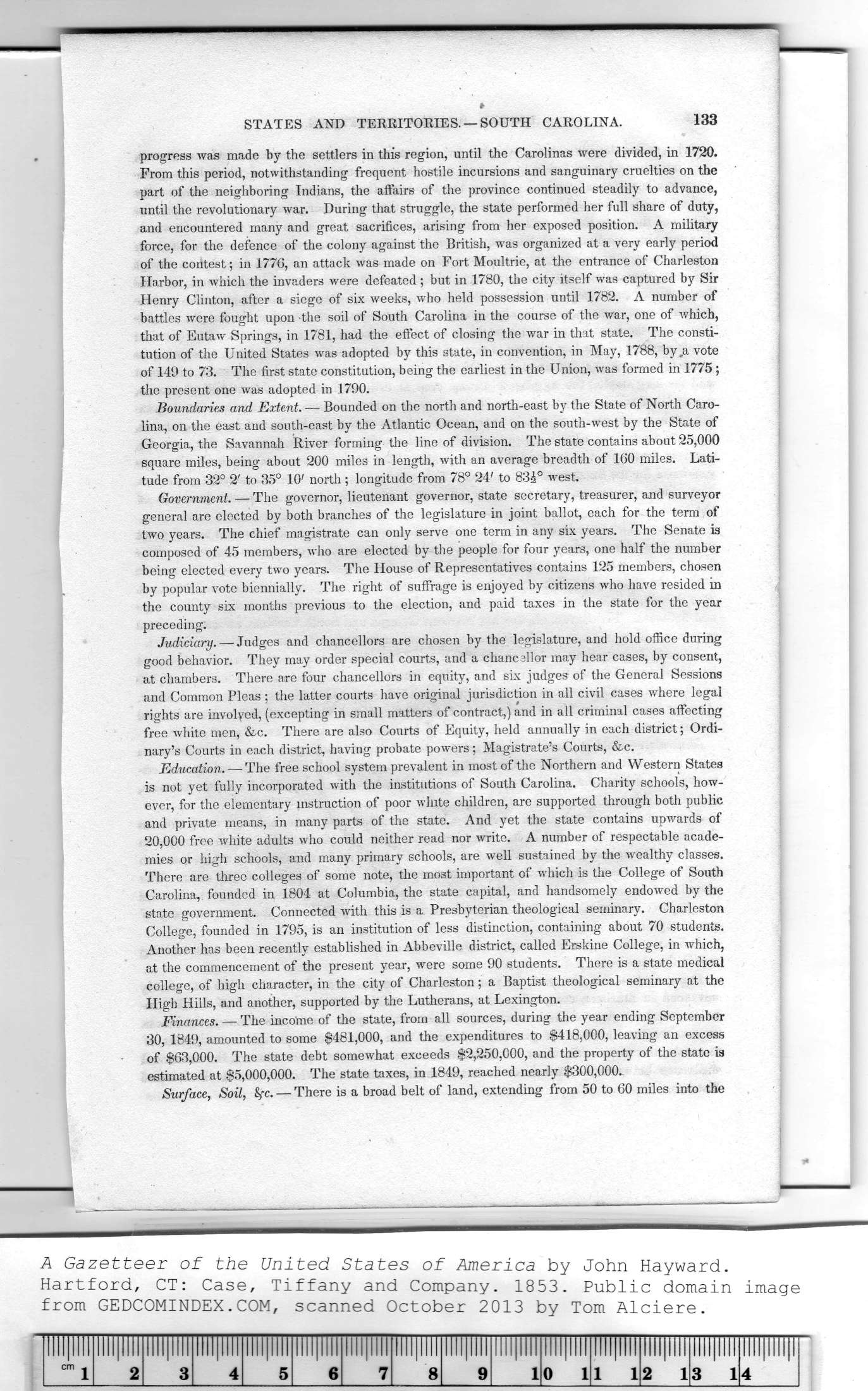|
|
Note: Ctrl and + increases the font size of the text below, Ctrl and - decreases it, and Ctrl and 0 resets it to default size.
STATES AND TERRITORIES. — SOUTH CAROLINA. 133
progress was made by the settlers in this region, until the Carolinas were divided, in 1720.
From this period, notwithstanding frequent hostile incursions and sanguinary cruelties on the
part of the neighboring Indians, the affairs of the province continued steadily to advance,
until the revolutionary war. During that struggle, the state performed her full share of duty,
and encountered many and great sacrifices, arising from her exposed position. A military
force, for the defence of the colony against the British, was organized at a very early period
of the contest; in 1776, an attack was made on Fort Moultrie, at the entrance of Charleston
Harbor, in which the invaders were defeated ; but in 1780, the city itself was captured by Sir
Henry Clinton, after a siege of six weeks, who held possession until 1782. A number of
battles were fought upon the soil of South Carolina in the course of the war, one of which,
that of Eutaw Springs, in 1781, had the effect of closing the war in that state. The consti-
tution of the United States was adopted by this state, in convention, in May, 1788, by,a vote
of 149 to 73. The first state constitution, being the earliest in the Union, was formed in 1775 ;
the present one was adopted in 1790.
Boundaries and Extent. — Bounded on the north and north-east by the State of North Caro-
lina, on the east and south-east by the Atlantic Ocean, and on the south-west by the State of
Georgia, the Savannah River forming the line of division. The state contains about 25,000
square miles, being about 200 miles in length, with an average breadth of 160 miles. Lati-
tude from 32° 2' to 35° 10' north; longitude from 78° 24' to 83£° west.
Government. — The governor, lieutenant governor, state secretary, treasurer, and surveyor
general are elected by both branches of the legislature in joint ballot, each for the term of
two years. The chief magistrate can only serve one term in any six years. The Senate is
composed of 45 members, who are elected by the people for four years, one half the number
being elected every two years. The House of Representatives contains 125 members, chosen
by popular vote biennially. The right of suffrage is enjoyed by citizens who have resided in
the county six months previous to the election, and paid taxes in the state for the year
preceding.
Judiciary. — Judges and chancellors are chosen by the legislature, and hold office during
good behavior. They may order special courts, and a chancellor may hear cases, by consent,
at chambers. There are four chancellors in equity, and six judges of the General Sessions
and Common Pleas ; the latter courts have original jurisdiction in all civil cases where legal
rights are involved, (excepting in small matters of contract,) and in all criminal cases affecting
free white men, &c. There are also Courts of Equity, held annually in each district; Ordi-
nary's Courts in each district, having probate powers; Magistrate's Courts, &c.
Education. — The free school system prevalent in most of the Northern and Western States
is not yet fully incorporated with the institutions of South Carolina. Charity schools, how-
ever, for the elementary instruction of poor white children, are supported through both public
and private means, in many parts of the state. And yet the state contains upwards of
20,000 free white adults who could neither read nor write. A number of respectable acade-
mies or high schools, and many primary schools, are well sustained by the wealthy classes.
There are three colleges of some note, the most important of which is the College of South
Carolina, founded in 1804 at Columbia, the state capital, and handsomely endowed by the
state government. Connected with this is a Presbyterian theological seminary. Charleston
College, founded in 1795, is an institution of less distinction, containing about 70 students.
Another has been recently established in Abbeville district, called Erskine College, in which,
at the commencement of the present year, were some 90 students. There is a state medical
college, of high character, in the city of Charleston; a Baptist theological seminary at the
High Hills, and another, supported by the Lutherans, at Lexington.
Finances. — The income of the state, from all sources, during the year ending September
30, 1849, amounted to some $481,000, and the expenditures to $418,000, leaving an excess
of $63,000. The state debt somewhat exceeds $2,250,000, and the property of the state is
estimated at $5,000,000. The state taxes, in 1849, reached nearly $300,000.
Surface, Soil, fyc. — There is a broad belt of land, extending from 50 to 60 miles into the
|
Illllllll |
Illllllll |
Illllllll |
Illllllll |
llll|llll |
Illllllll |
llll|llll |
llll|llll |
llll|llll |
Illllllll |
Illllllll |
Illllllll |
Illllllll |
Illllllll |
Illllllll 1 |
|
uftl j |
2 |
3 |
4 |
5 |
6 |
7 |
8 |
9 |
1 |
0 1 |
1 1 |
2 1 |
00 |
4 |
|
